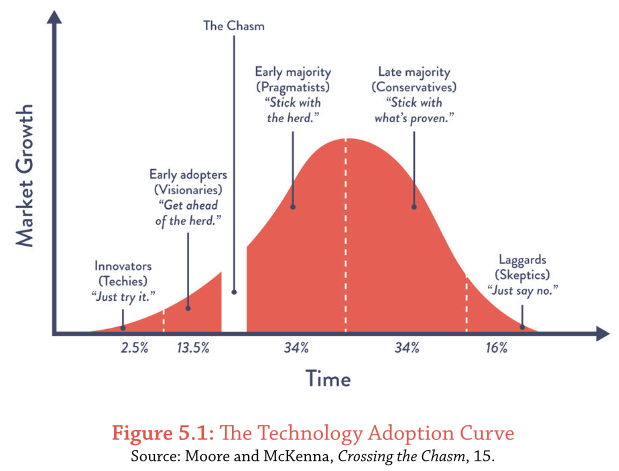Dans la section précédente, nous évoquions l’aménagement du temps pour les personnes ACTIVES de l’entreprise. Et cette idée vient parfaitement se compléter avec une section du Chapitre 5 du livre The DevOps Handbook
Within every organization, there will be teams and individuals with a wide range of attitudes toward adopting new ideas; Geoffrey A. Moore first depicted this spectrum in the form of the technology adoption life cycle in Crossing the Chasm, where the “chasm” represents the classic difficulty of reaching groups beyond the innovators and early adopters.

En d’autres termes, les nouvelles idées sont souvent rapidement adoptées par les innovateurs et les adeptes de la première heure, tandis que d’autres personnes aux attitudes plus conservatrices - telles que la majorité précoce, la majorité tardive et les retardataires - ont tendance à y résister; L’objectif est de trouver ces équipes/personnes qui croient à YYY et qui démontrent à la fois un désir et une capacité à innover et à améliorer leurs propres processus.
J’ai volontairement mis YYY car le livre The DevOps handbook se concentre sur la mise en place da la philosophie DevOps, mais YYY peut être remplacer par n’importe quel sujet (Agile, microservices, etc …).
⇒ L’objectif n’est pas de dépenser du temps à convaincre les autres, mais au contraire dépenser de l’énergie à mettre en place YYY puis la masse suivra.
Étendre YYY à toute l’organisation
Les phases idéale pour propager YYY à toute une organisation
- Find innovators and early adopters: In the beginning, we focus our efforts on teams who genuinely want to help—our kindred spirits and fellow travelers who are the first to volunteer to start the YYY journey; ideally, these are also respected individuals with a high degree of influence across the organization, lending our initiative greater credibility.
- Build critical mass and the silent majority: In the next phase, we expand YYY practices to more teams and value streams with the goal of creating a stable base of support; by working with teams receptive to our ideas—even if they aren’t the most visible or influential—we grow our coalition, generate more successes, and create a “bandwagon effect” that amplifies our influence, all while deliberately avoiding political battles that could jeopardize the initiative.
- Identify the holdouts: The “holdouts” are high-profile, influential detractors who are most likely to resist—or even sabotage—our efforts; in general, we address this group only after we’ve achieved a silent majority and established enough successes to protect the initiative effectively.
En lien également avec le changement de la culture dans une organisation Accelerate - Comment changer la culture ?